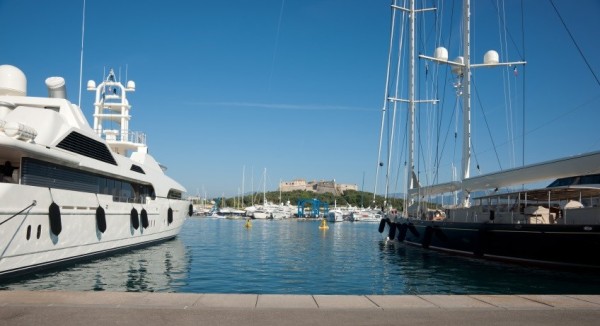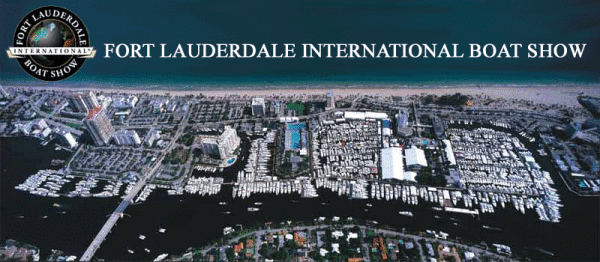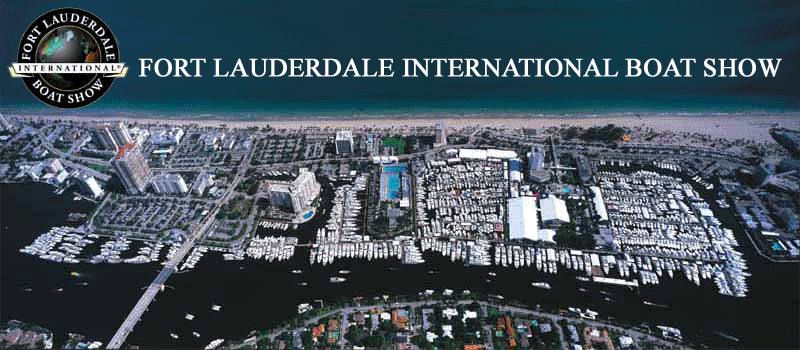In Part 1 of this series on yacht crew hiring ports, I covered worldwide locations where yacht crew must move to find work on a superyacht. While I listed the Tier 1, 2, and 3 destinations for getting hired quick, my advice for entry-level crew is that they should choose one of the top four hiring ports (Tier 1), which include Fort Lauderdale, Florida and Newport, Rhode Island in the U.S. and Antibes, France and Palma de Mallorca (Spain) in the Mediterranean.

Antibes, on French Riviera — with the fortress in the distance. Antibes is the major yachting hub in the Mediterranean.
With those four top hiring ports in mind, that leads us to the next important question: when?
What Criteria Do You Use to Choose a Hiring Port?
Aside from your proximity to the destination and what restraints, if any, your travel budget may pose, the two main factors to consider when choosing a hiring port are:
- what yachting season coincides with your job-hunting schedule (and you are better off planning your job hunt according to the yachting seasons, rather than just heading wherever is most convenient when you feel like it).
- what visa requirements you face, which for U.S. citizens is a non-issue.
Seasonal Decisions
When referring to the industry’s main seasons, we look at what times of the year a MAJORITY of yachts converge upon the same geographic cruising areas. While it is true that luxury yachts are constantly on the move and can end up in ports all over the world (this is why I say it’s not impossible to find work outside of the main hiring ports), consider seasonal trends to increase your chances of getting hired.
The question to ask is: “What do most yachts do, and when do they do it?”
There are two actual cruising seasons you will hear discussed in this industry: summer and winter. The months on either side of the summer and winter seasons—what in layman’s terms are known as spring and fall—are most often referred to by yachting professionals as the time when yachts are “getting ready for the summer season” (April–mid-June) and “getting ready for the winter season” (September–mid-December).
These two off-shoulder seasons, also referred to as “down time” for yachts, serve as transition periods when yachts are changing locations, heading into shipyards for repair or maintenance, and provisioning for the next cruising season’s big string of charters. This is usually the time when current crew take their vacations.
And pay attention here: These transition months are also the peak time periods for finding jobs, as this is when crew changes will most likely occur.
So where do the yachts end up during these transition periods? Well, naturally, the industry’s cruising seasons are dictated by when and where the weather is warm and pleasant. In the South of France, the port of Nice (pronounced like “niece”) is nice, but not necessarily in late November.
A couple main events that coincide with these time periods are Antigua Race Week in late April (after which time most yachts head back to Fort Lauderdale for transitioning over to summer season plans) and the Fort Lauderdale International Boat Show at the end of October, when you can be guaranteed there are tons of yachts in town.

Fort Lauderale, Florida is known as “The Yachting Capital of the World”. It hosts the Fort Lauderdale International Boat Show each year at the end of October / beginning of November. This is a peak hiring time for yacht crew.
Other big superyacht industry events during such transitional periods are the Monaco Yacht Show in late September, which could offer a last chance to hop on a yacht in the Mediterranean that is heading back across the Atlantic for Caribbean winter cruising, and the Antigua Yacht Charter Show in early December that tends to kick off the winter season in the Caribbean.
Here below I break down these various cruising seasons (where yachts travel when) and follow it up with a useful table to summarize the peak months for finding work in the four main hiring ports: Fort Lauderdale, Antibes, Palma, and Newport. Read on…
Summer Season
During the summer months (May to early September), most yachts either travel across the Atlantic Ocean to cruise around the Mediterranean Sea OR they head up the northeast coast of the United States to areas such as Newport, Rhode Island; Martha’s Vineyard and Cape Cod in Massachusetts; and New York City and Sag Harbor in New York. Some also venture up the West Coast of the United States to visit Alaska, though typically only in June, July, and August, given that the temperatures are best those months.
Between Summer and Winter
As the summer draws to a close, usually in mid-September to early October, many yachts will finish up their cruising season and head into transitional phase. (That means a peak hiring time.) Yachts already located in the Mediterranean may opt to go into a shipyard somewhere in Europe. Unless they have a good reason to be there, though, most boats clear out of that area and head back across the Atlantic. Yachts that were in the U.S. Northeast for the summer will also migrate back down south, nearly always stopping off somewhere in South Florida before departing again for the winter season, usually to the Caribbean. And, yachts that ventured to Alaska will do one of a few things: head down the West Coast to winter in Mexico, head elsewhere across the Pacific Ocean, or transition over to South Florida, in preparation for Caribbean cruising.
Winter Season
During the winter months (late November through March), most yachts cruise to the islands of the Bahamas and the Caribbean, including St. Martin/St. Maarten, Antigua, the Virgin Islands, and St. Barts. Those that do not head there are based in Florida during these months, are in a shipyard elsewhere (such as Europe), or follow an atypical itinerary and are located in parts of the world such as Australia or the islands of the South Pacific. If you are seeking employment for the Caribbean season and have not found anything out of the Lauderdale-based agencies by early December, it is recommended (at least for experienced crew) that you look into heading to the Caribbean to find work. (And if you are thinking of heading to St. Martin / St. Maarten, see the final note at the bottom of this post.)
Peak Times to Find Yacht Crew Jobs (‘Tis All in the Seasons)
The chart below summarizes the peak times to find yacht crew jobs according to location, with notes beneath to explain further:
LAUDERDALE, FLORIDA, USA | FRANCE | MALLORCA, SPAIN | RHODE ISLAND, USA |
|
| January | ||||
| February | ||||
| March | ||||
| April | ||||
| May | ||||
| June | ||||
| July | ||||
| August | ||||
| September | ||||
| October | ||||
| November | ||||
| December |
- No = As an entry-level job seeker, don’t try it.
- Good = A decent chance, but you may find yourself either a bit too early, or too late, for prime hiring season. In the case of Fort Lauderdale, many of the agencies will be hiring to send crew down to the Caribbean during January-February (that’s how it happened for me: hired in Lauderdale to join a boat in San Juan, Puerto Rico), so this is why they have received the rating of “Good.” Otherwise, the yachts hanging around Florida during these months are more than likely having repairs done and are not hiring.
- Great = Your odds are increasing. In fact, for months and locations where I have noted the hiring possibilities as “Great,” if these months are followed by a month rated “Outstanding,” you may actually choose this “Great” month to arrive in town. This will give you time to complete your STCW training, an interior training course, and to get some day-work experience under your belt so that you can be networked and poised to grab the jobs that become available during the months marked as “Outstanding” times to find permanent positions.
- Outstanding = Be here during this time for the best chance to find a job.
If you have not yet read Part 1 of this series on Yacht Crew Hiring Ports, you can find that here.
Or simply pick up a copy of my book, The Insiders Guide to Becoming a Yacht Stewardess, which devotes six full chapters on how to get hired as superyacht crew. This information will be useful for anyone trying to obtain work on a yacht, whether you are looking for an entry-level yachting position as a deckhand, steward or stewardess, chef, or even an engineer.
Final Note: If you are “green” (a novice to the industry), and you haven’t found work in Fort Lauderdale by mid- to late December, you will likely receive advice from other crew in town that you head to the island of St. Martin / St. Maarten to continue your job search down there. Please take heed:
Experienced crew report that St. Martin/St. Maarten and Antigua make great bases for finding work at the start of the holiday season in mid- to late-December, through February; however, I encourage you to exercise caution if heading to these areas alone. Connect with crew agencies ahead of time for an honest assessment of the job market. I also recommend traveling with another person and not making your intentions for job-hunting known when you speak to immigration officials at the airport. Go with a return flight booked (that you can always cancel), and make sure you’ve arranged your accommodation in advance. Do your research.
Current yacht stewardess, Kate Chastain (who also assisted with research for the 2nd edition of this book) says this about job hunting in St. Martin/St. Maarten:
It is not a port I would necessarily recommend to a green stew. It is “illegal” to dock walk (although I’ve done it many times after learning some tricks), and passengers with one-way tickets into the island are often stopped at customs, questioned, and not released until a departing flight (which you can cancel later) is purchased. I wish I had known to be careful on the island when I went there during my first year in the industry and found myself in customs, passport being held. I was then horrified when I realized how DIFFERENT it was from looking for work in Fort Lauderdale. Now that I know what to expect, I have returned looking for work two years in a row with no problems. For someone new to the industry though, it is not advised.”
So be cautious.
Meanwhile, if you wish to take a few steps back and get a better idea about the superyacht industry—what its all about, who owns and travels aboard megayachts and superyachts, where they travel, and even what they’re like inside—feel free to download Chapter 1 for free here.





[…] Above I tell you where you need to move to get hired. The next question you’re probably asking is “when?” Sure enough, that’s what I talk about in Part 2 of this series on Yacht Crew Hiring Ports. […]